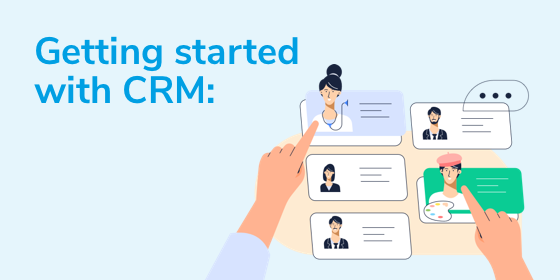Getting started with Candidate Relationship Management

Relationship management instead of straight recruitment
Recruitment processes are often repeated without making use of the long-term potential that arises. Valuable contacts are ‘lost’ along the way, for example, because the candidate was undecided or the applicant did not fit the job profile one hundred percent. Yet they are still of interest to the company. Candidate relationship management (CRM) is about transforming the straight recruitment process you may have followed until now into a cycle (also called a recruiting wheel). Here, instead of ending contact with talented people, candidates and applicants, you keep in permanent contact with them – both with the aim of a possible future appointment and with regard to their function as multipliers for your employer brand. However, the general watering can principle does not work. Content, timing, and channel must fit the respective situation of the recipients. This is the only way to create relationships during the candidate journey that improve the candidate’s experience, strengthen your employer brand, and ultimately lead to a shorter time-to-hire
“CRM light”: How to get started with candidate relationship management
Nevertheless, recruiters often find it difficult to change existing structures. “A linear process – from the job ad to application and then hiring – as followed in classic recruitment is not the order of the day with candidate relationship management,” Michael Eger, Partner at Mercer | Promerit, knows from numerous consultancy projects around CRM. “Instead, companies acquire many more direct contacts (e.g. through direct approaches and use of networking, etc.), although the initial contact does not necessarily have to lead to a direct hire. Often more touchpoints over a longer period of time are necessary before an interesting talent lead actually becomes an applicant”. This frequently means a complete overhaul of recruitment processes. But how do you go about it? Before you consider this undertaking too difficult, you should know: there is also a ‘light’ version.
- 🎯#1 Narrow down the target group: The larger and more differentiated the target group is, the more time and effort it takes to maintain contact. So when starting CRM, you should have a clearly defined target group. For example, this could be students in a certain field or IT experts with specific technical experience relevant to the company. Jobs that you frequently advertise or those usually difficult to fill are also ideal.
- 💡#2 Develop an example scenario: Find touchpoints through which you can reach this target group – your so-called talent leads. Keep in mind a possible candidate journey that should ultimately lead to an application (Example: Tweet -> blog post -> career website -> survey (download) -> email with invitation -> visit to an event -> application).
- 🔍#3 Simplify sourcing: “Often there are no applications from very narrow target groups. Suitable candidates need to be searched for in social networks”, says Michael Eger. It, therefore, makes sense to look for ways of simplifying your sourcing activities. For example, use a special browser extension to easily import details of talent leads from career networks into a central database (talent pool).
- 💪#4 Create a talent pool: “Headhunters are expensive and often not necessarily successful with very specific target groups. The alternative: build networks and pipelines to be independent and don’t leave the pipeline know-how to third parties”, advises Michael Eger. Set up a talent pool for centrally managing all profiles, with easy access for all those involved in sourcing and recruitment in real-time, including contact history and the option to systematically categorize and search intelligently. For a GDPR-compliant dialogue with your talent leads, the software should work with automated consent management.
- 🥈#5 Stay on the ball: Work with smart tools such as ‘reminders’ to retarget interesting candidates. In this way, you build a relationship with your talent leads; and are on the spot, for example when a student that you met at an event is about to graduate and open to an attractive job offer. Incidentally, these could also be former interns or working students with whom you have had a good experience. You should also keep an eye on so-called “second best” candidates from previous interviews.
- 🚀#6 Develop nurturing campaigns (for advanced users): Compile relevant generic (e.g. seasonal or general) content and specific (e.g. personal or subject-specific) content for automated campaigns that are chronologically structured. Reference points could be a specific phase in the recruitment process, a known willingness to change, the original source of contact, a particular qualification, etc. Important: the longer a talent lead has been in the pool and the more touchpoints generated, the more specific and personal the approach should be in order to steer that person towards an application.
Want to know more? How to expand your CRM
Once you have established the first CRM structures in your company, you can successively expand the talent pool and capture new target groups. For example, add a simple registration form to your career website for those who do not wish to apply immediately, but would like to be kept informed about career opportunities. Build a pool of second-best candidates who didn’t get through past selection rounds, but were at least identified as promising candidates. You can then approach these candidates directly in the event of future vacancies. Speculative recommendations from your own staff are also a valuable addition to your talent pool. Experience shows that they have a very good cultural fit.
Efficient, targeted recruitment with the right platform
For companies learning the ropes, CRM can appear to represent a lot of work. But with a systematic approach, starting with manageable measures, you can make a good start. “In any case, a functioning CRM concept is definitely an important competitive advantage. Michael Eger from Mercer | Promerit knows from his professional experience that, “when you consider headhunters can easily ask for 25 percent of the first year’s salary for hard to fill vacancies, investment in the system and in the recruitment organization quickly pays for itself”. The decisive thing is the platform that will help you to automate processes, manage CRM strategies and gradually expand the talent pool as a single source of truth – ideally connected seamlessly to your applicant management system.
The uniform availability of candidate information and simple rights management not only makes collaboration within the team more efficient but also improves the candidate experience. Not least because the issue of different recruiters talking to the same candidates simultaneously is avoided. And rather than starting each recruitment activity from scratch, you can significantly reduce the time-to-hire because you’ll have suitable talent leads you can draw on at any time and in a targeted manner.





.png)


